Ronesa Aveela's Blog, page 3
September 26, 2023
Do Vampires Eat Dung?
The Western world is filled with stories of blood-sucking vampires that they say came from Slavic lands. In fact, the original Slavic vampire was not a Dracula-clone. This blood-sucking behavior was transferred to Slavic vampires only after the graves of supposed vampires were dug up. It was then that people noticed the deceased bloated body and a residue around the mouths that was taken for blood. Obviously, good ole Freddie (may he rest in peace) has been out having the time of his life (or death, as it were) drinking the blood from anyone he chose.
And why were these graves desecrated in the first place? Because of a rash of deaths, illnesses, crop failures, you know it. Anything that went wrong had to have been the fault of those pesky vampires.

“The Vampire”, lithograph by R. de Moraine (1864). From: Féval, Paul-Henri-Corentin. (1864) “Les Tribunaux Secrets.” Paris: Boulanger et LeGrand. Vol. 2, p. 112. Public domain via Wikimedia Commons.
That being said, in folklore, blood did play a part in some of the vampiric traits. When the decease first made its way out of the grave, it would have a rather odd form: a shapeless, jelly-like bag of blood. Inside, it lacked bones. This shape allowed it to escape from the grave through any tiny crack or opening.
These kinds of vampires cause mostly harmless mischief around the community, although he did drink blood for sustenance, but for the most part, these vampiric troublemakers, in death, got payback on those who were their enemies in life. The undead haunted homes like a poltergeist. They made noises in the attic, broke dishes, created a mess in the kitchen and pantry, tormented livestock, and other such misadventures. This all lasted until the first rooster crowed. Then back to the grave the vampire went.
If you wanted to get rid of the vampire or recognize him as one, you’d have to do so within the first 40 days after the deceased was buried. As he continued to drink blood, he gradually took on human form again, even though he still lacks bones. Stronger, he can even go about life as he did before and not have to creep back when daylight arrives. To avoid being recognized, he’ll travel to another village to life his new undead life. He may marry again and become either a butcher or a barber. However, a single cut to himself, or you can prick him with a hawthorn thorn, and boom, he bursts to become a pool of blood and that jelly-like substance he after is still remains.
But the title implies he eats dung, you say. Yes, this is true. This is how the vampire survives when not drinking blood. He consumes animal refuse.
How Vampires Come into ExistenceVampires were among the spirits, or undead, affected by this. The Slavs held many beliefs about how a person could become a vampire: a cat or other animal leaping over the corpse or its grave, a bird flying above the body, or even a shadow falling onto the body or grave could trigger the curse. One major factor determining this was improper burial procedures. If the prescribed customs and rites were not performed or were done so incorrectly or not completely (such as a body that was not washed properly), lock the doors. Good ole Freddie was coming back after you.
If you’re not sure if you did all the rites correctly, one method of protecting a deceased loved one from becoming a vampire is to make his coffin from maple or pine. On top of that, you can lay inside the coffin grasses and herbs blessed on the Feast of the Transfiguration.
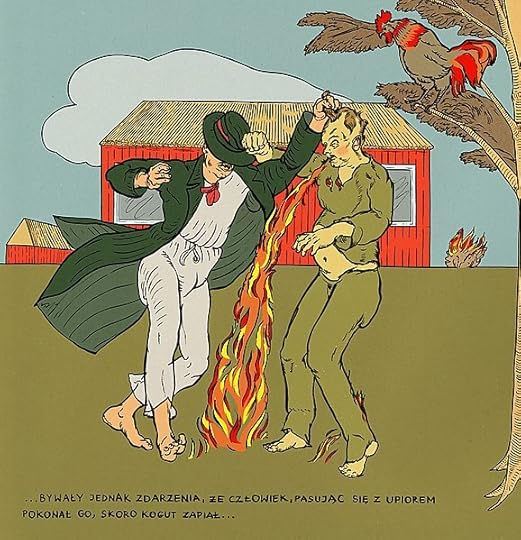
Graphics by Maciej Sieńczyk for Oskar Kolberg’s text on the physical confrontation of Polish peasants with ghosts (Lubelskie, Part 2). Source: Adam Mickiewicz Institute – Project: Phantom, via Wikimedia Commons.
Some people never even had a chance. Those who died a violent death (murdered, struck by lightning, falling to their death, for example), or committed suicide, were more than likely to come back as some kind of monster or evil spirit, vampire included. Not only them, but people who led what were considered “evil” lives could come back as vampires, even if they lived to a ripe old age: thieves, murderers, drunkards, lechers, whores, sorcerers, and so on. These people were not even allowed to be buried in consecrated ground. Outside the churchyard they went.
One suggested reason for so many dead becoming the undead among the Slavs was that in pre-Christian times, the dead were cremated, separating their spirits or souls from the body and allowing them to fly free to the otherworld. Orthodoxy, however, demanded that the body be put into the ground because of the spiritual belief in the bodily resurrection. Therefore, in order to prevent poor ole Freddie from making his way out of the grave, precautions were put into place, such as stones in the deceased’s mouth or a sickle across his throat.
Not only people can turn into vampires after they die, but so can objects. Any object left outside under a full moon will become a vampire. Specifically, this applies to pumpkins. If you leave it outside for ten nights, full moon or not, it will become a vampire. The vampiric pumpkin begins to shake and make a “brrrr” sound (I guess it got cold being left outside for so long). Then it will make its way inside your home and do you harm. Fortunately, being as they are still pumpkins, the damage the do is minimal. If you’re unsure whether your pumpkin has turned into a vampire or not, check for a drop of blood somewhere on it.
Protecting Yourself from a VampireIf you’re out and about at night and you sense you’re being stalked by a vampire, you can protect yourself by swallowing some of the earth from the creature’s grave. However, this also results in you yourself becoming a vampire when you die. And what is the likelihood you’d have some of that special dirt on your person at the time?
A better protective method is to leap across a stream if you can, as these kinds of creatures cannot cross water (unless carried over). Salt is something the creature fears, and this is more readily available than coffin dirt. Other objects the vampire fears (at least in more modern folklore) are a piece of iron that’s been broken up, hawthorn, wild rose, garlic, and tar. He also cowers in thunder. If his grave is struck, there goes the vampire as well. If it’s the first storm of the season, the mere sound of the thunder itself can vanquish your undead foe.
This just touches the tip of the iceberg that is the Slavic vampire. And much of this has been influenced by the western world and the whole blood-drinking monster belief. A future book in our “Sprits & Creatures” series will take a deeper dive into the who and what of the Slavic vampire of folklore.
September 15, 2023
Mystical, Magical Firebird, Champion of the Poor
The Firebird (Zhar-ptitsa) is a creature found in the wonder tale (volshebnaia skazka). She represents a rare treasure. Her eyes are crystals, and her feathers are silvery, golden, or orange-red and glow like embers. A single feather shines brighter than numerous candles. It can brighten a room as if a thousand lights were shining within or as if the setting sun itself illuminated the room. When the light in the feather finally dims and goes out, the feather itself turns to gold. Like attracts like, and so the feather, being a treasure, will enable one to find other treasures, particularly gold within the earth.
Her feathers burn to the touch. Because of her flaming feathers, she is linked to the sun. She is said to be the keeper of the world. She covers the fiery vision of the sun to protect all Earthly life from being devoured by the heat of the sun.
She lives an idle life eating and singing. Her diet is golden apples or magical grasses. The apples are prized by humankind because they bestow youth, beauty, and immortality on the consumer. Her song is a powerful healer. It can cure any disease, prolong life, and restore sight to the blind to any who listen to her sing. When she sings, lightning appears and pearls fall from her beak.
A single feather, whether taken from her or found by the wayside, has magical powers and its golden color is a symbol of prosperity. But to take a feather spells doom. It becomes a blessing and a curse for the one who bears the feather on his journey.
Rich men lust after the Firebird. When they see a single feather that glows bright as the sun, they desire to hold her captive in a golden cage to behold her beauty and listen to her enchanting song. She is said to live in a garden in Iria, where the Tree of Live grows. But when she flies free at nighttime, it is poor to whom the Firebird shows her benevolence.
She becomes a Slavic Robin Hood, a folk hero, stealing golden apples from the rich and giving them to the poor. Lacking apples, she’ll drop pearls from her beak as she flies over peasant villages. These treasures, although by themselves have no use to the peasants, are a means for them to trade for food, clothing, and every other necessity for their humble existence.
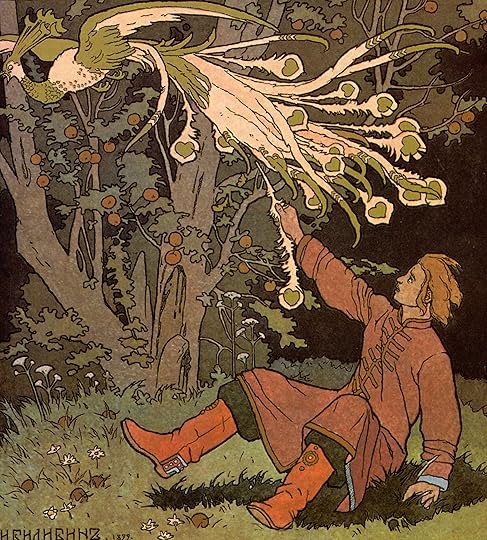
Ivan Bilibin’s illustration of “Tsarevitch Ivan, the Firebird and the Gray Wolf.” Public domain, via Wikimedia Commons.
OriginsWhere did this marvelous bird come from?
The Firebird has been said to be descended from the god Simargl, a winged dog, who was the protector of seeds, new shoots, and roots. The name Simargl is theorized to have come from simurgh, a Persian magical bird-deity. Although both of these concepts are debatable. The simurgh, however, was a mediator between worlds as is the Firebird.
Some sources claim that Perun, the Slavic god of thunder, traveled in the guise of the Firebird when he left the thirtieth kingdom. This was a fertile and prosperous land, where the Slavic pantheon was said to live. The fruit on the trees added years to one’s life, and the waters there restored life.
A medieval Russian creation story says it was the Firebird who soared over the great ocean that engulfed the universe. Within the primal chaos, she laid an egg from which all life was brought forth, as well as Heaven, the Earth, the Underworld, and all the stars.
Another legend places the Firebird in the Garden of Eden. She observed mankind’s downfall after Adam and Eve ate of the forbidden fruit (which some sources say was the quince, which has been called a golden apple). While all others in the garden also partook of the taste-test, the Firebird alone refrained. For her loyalty, God granted the bird immortality, but that came with a cost. She would suffer a painful death each autumn to be reborn in the spring. Other tales say each dawn, she enters a death-like sleep, from which she revives when the sun sets.
One TaleThe golden-apple stealing Firebird in “Tsarevitch Ivan, the Firebird and the Gray Wolf” is perhaps one of the most well-known stories about this mythical creature. Ivan Bilibin’s illustration portrays this story wonderfully. I’ve always been fascinated by this renowned artist’s colorful illustrations. Back in 1990, I had the opportunity to visit Moscow. A street called Arbat is filled with art. Think of Montmartre in Paris. The Arbat has existed since at least the 15th century, which makes it one of the oldest surviving streets in the Russian capital. Among the many other fascinating artwork, I discovered hand-painted boxes from the famous Palekh school. These, as well as a reproduction of a book with Bilibin illustrations, now are part of my collection. One of the tales is in the book is “Tsarevitch Ivan, the Firebird and the Gray Wolf.”
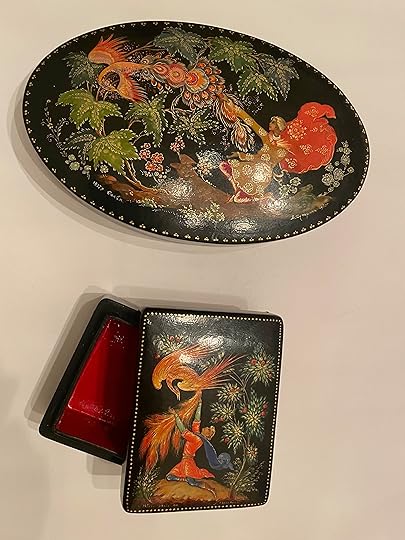
But, the Zhar-ptitsa appears in other tales, as well, like the summary below from Ralston’s Russian Folk-tales. (London: Smith, Elder & Co., 1873, pp. 283-285, tale taken from Khudyakof, No. 110, from the Nijegorod Government).
It had been predicted that a certain baby princess would begin flying about the world as soon as she was fifteen. So her parents shut her up in a building in which she never saw the light of day, nor the face of a man. For it was illuminated by artificial means, and none but women had access to it. But one day, when her nurses and Mamzeli had gone to a feast at the palace, she found a door unlocked, and made her way into the sunlight. After this her attendants were obliged to allow her to go where she wished, when her parents were away. As she went roaming about the palace, she came to a cage in which a Zhar-Ptitsa, ‘lay [as if] dead.’ This bird, her guardians told her, slept soundly all day, but at night her papa flew about on it. Farther on she came to a veiled portrait. When the veil was lifted, she cried in astonishment ‘Can such beauty be?’ and determined to fly on the Zhar-Ptitsa to the original of the picture. So at night she sought the Zhar-Ptitsa, which was sitting up and flapping its wings, and asked whether she might fly abroad on its back. The bird consented and bore her far away. Three times it carried her to the room of the prince whose portrait she had so much admired. On the first and second occasion he remained asleep during her visit, having been plunged into a magic slumber by the Zhar-Ptitsa. But during her third visit he awoke, ‘and he and she wept and wept, and exchanged betrothal rings.’ So long did they remain talking that, before the Zhar-Ptitsa and his rider could get back, ‘the day began to dawn—the bird sank lower and lower and fell to the ground.’ Then the princess, thinking it was really dead, buried it in the earth—having first cut off its wings, and ‘attached them to herself so as to walk more lightly.’
After various adventures she comes to a land of mourning. ‘Why are you so mournful?’ she asks. ‘Because our king’s son has gone out of his mind,’ is the reply. ‘He eats a man every night.’ Thereupon she goes to the king and obtains leave to watch the prince by night. As the clock strikes twelve the prince, who is laden with chains, makes a rush at her; but the wings of the Zhar-Ptitsa rustle around her, and he sits down again. This takes place three times, after which the light goes out. She leaves the room in search of the means of rekindling it, sees a glimmer in the distance, and sets off with a lantern in search of it. Presently she finds an old witch who is sitting before a fire, above which seethes a cauldron. ‘What have you got there?’ she asks. ‘When this cauldron seethes,’ replies the witch, ‘within it does the heart of Prince Ivan rage madly.’
Pretending to be merely getting a light, the princess contrives to splash the seething liquid over the witch, who immediately falls dead. Then she looks into the cauldron, and there, in truth, she sees the prince’s heart. When she returns to his room, he has recovered his senses. ‘Thank you for bringing a light,’ he says. ‘Why am I in chains?’ ‘Thus and thus,’ says she. ‘You went out of your mind and ate people.’ Whereat he wonders greatly.
Kickstarter CampaignThe Firebird plays an integral role in our story and is at the center of an evil demon’s plot to conquer the world.
We’re planning to launch the complete Dragon Village series on September 26. Here’s a preview of our campaign story.
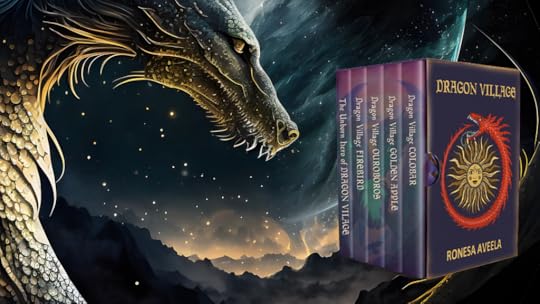
Dangers lurk in Dragon Village, but also secrets. Can Theo solve the mysteries before an evil creature conquers the magical and human worlds?
Do you have an adventurous soul, ready to encounter strange magical creatures?Have you ever wished you could travel through a portal to another world?Do you love the reluctant hero, strong female friends, and quirky sidekicks?If this sounds like you, then step through the gate into the magical world of Dragon Village.
Campaign link: https://www.kickstarter.com/projects/ronesa-aveela/dragon-village?ref=3i92sy
If you’re interested in other Bulgarian beliefs, why not check out one of our book Light Love Rituals: Bulgarian Myths, Legends, and Folklore, available direct from us or from retail stores.
September 8, 2023
Laughter in the Forest – A Walk with Leshy (part 2)
Last week, we talked about Leshy’s “good” side. Although some people may think that pranking is not good, in these instances, Leshy didn’t do any real damage to anyone. He just had a good laugh. His “bad” side, however, was not always so humorous.
First, let’s talk about a few of his vices.
According to some sources, Leshy likes to drink. After a long night of carousing, when he’s incapacitated, his friend the bear stands guard to protect this forest spirit. When the bear is not around, a wolf will watch over his master. For bear and wolf, and even horned owl, are Leshy’s faithful companions.
He’s also a card player and is wont to gamble away squirrels and mice and other creatures he’s in charge of in one fell swoop. This is much to the annoyance of the villagers who hunt in those woods. For, lo and behold, a mass migration occurs after Leshy loses to another of his kind. The debt has to be paid, and the winning Leshy now has double his possessions. Some people describe him as a demon. So, when he plays cards, the deck lacks clubs, since they are said to resemble the cross.
As you can imagine, if one Leshy loses to another, it’ll cause ill will between them. Battles take place. Anyone wandering through the forest after one of these events will come across trees uprooted as if a hurricane passed through the area. But unlike the devastation a hurricane causes, the disturbed area is only a small space.
This kind of fighting usually occurs in early spring right after he’s woken from his winter slumber. He has so much pent-up energy that he has to let it out somehow. Thankfully, this doesn’t last too long, and soon he’s back to protecting the forest and its animals. During the summer, he like to play tricks. As autumn approaches, he starts getting riled up again, knowing he’s in for a long winter hibernation. If it wasn’t a battle taking place, it could also have been Leshy’s wedding ceremony. During the feasting, Leshy causes so much discord that the birds and beasts alike vacate the scene.
And to add to these vices, he likes a good smoke. If you feel up to it, when you leave him gifts in the forest, don’t hesitate to propitiate him with some tobacco as well. If you find that you feel ill after being in the forest, it’s likely you forgot to leave him some kind of offering, whether it’s tobacco or one of the other things he enjoys.
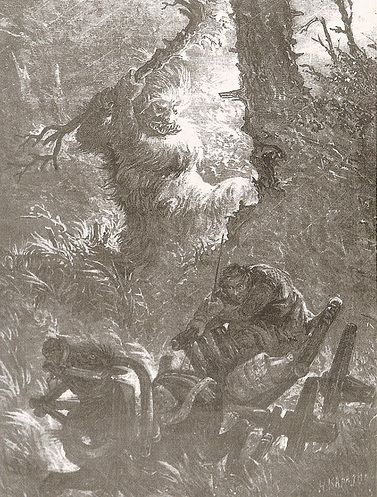
I. I. Izhakevich. Leshy. Drawing from Niva magazine. 1904. No. 22.), Public domain, via Wikimedia Commons.
If you’ve happened to run across Leshy without knowing it, and you’ve done nothing to make him accept you in his domain, when you exit the forest, you’ll be covered with moss. Worse, you may be mute. Even if you get your voice back, from that point on, you’ll be unable to concentrate, and you’ll act oddly. It could be even worse. If an angry Leshy finds you, he may tickle you to death.
Another of the negative traits of Leshy is that he has been known to abduct humans. He may be lusty and steal maidens to be his slaves. Or, he may steal children, particularly if a parent or woman during childbirth curses her offspring by saying, “May Leshy take you.” He takes you up on the offer.
Girls they raise become rusalki, while boys become other Leshys if they are not found within seven years and their names blessed. The children may be taught secret healing knowledge that they bring back to their community when they are set free or escape. In other cases, however, the children may become wild. They forget how to speak, and they stop wearing clothing. Moss is their attire. Over time, these children lose shape and become invisible.
When he steals your child, there’s a good chance he’ll replace him with either a piece of wood of a child of his own. You’ll know this is the case because this changeling is not very intelligent and has a voracious appetite. If that child tries to return to his first home, the forest, he fails and becomes a tramp.
The moral of the story is to do a few simple things before you enter the forest. Be kind. Be respectful. Be generous. And take only what you need.
Kickstarter CampaignThe Lesnik in our story likes to have fun. He’s not one to kidnap or harm, but he also like to drink and play cards.
We’re planning to launch the complete Dragon Village series on September 26. Here’s a preview of our campaign story.

Dangers lurk in Dragon Village, but also secrets. Can Theo solve the mysteries before an evil creature conquers the magical and human worlds?
Do you have an adventurous soul, ready to encounter strange magical creatures?Have you ever wished you could travel through a portal to another world?Do you love the reluctant hero, strong female friends, and quirky sidekicks?If this sounds like you, then step through the gate into the magical world of Dragon Village.
Campaign link: https://www.kickstarter.com/projects/ronesa-aveela/dragon-village?ref=3i92sy
If you’re interested in forests and tree, why not check out one of our latest books, Magical Healing Trees in Slavic Folklore, available direct from us or from retail stores.
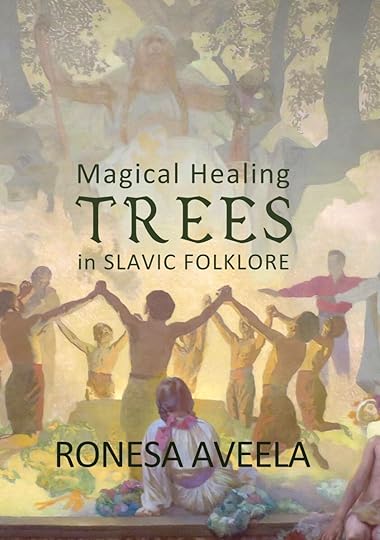
September 1, 2023
Laughter in the Forest – A Walk with Leshy (part 1)
Les means forest, so this nature spirit’s name is “one from the forest.” He’s probably most commonly known as Leshy, but he goes by similar names depending on the country of origin. Among the Bulgarians, he is Lesnik. This creature, like many Slavic ones, has a good side and a bad side. Today, we’ll show you his lighter side, and next week we’ll discuss his vices.
Leshy is the protector of his domain. Although he allows hunters to hunt and woodsmen to cut down trees—if they ask permission and use moderation in their endeavors—you’re also likely to hear him weep whenever a tree is cut down. He knows you need it for fuel, housing, or domestic items, but it breaks his heart nonetheless.
When the forest spirit is not out doing his rounds, he likes to live in a cave or a hollowed-out old mossy-covered fir. If he’s more sociable, he’ll marry and build a spacious home in the forest for his family. His bride may be another of his kind, a Lesovikha, or even a swamp Kikimora.
Leshy is a shape-shifter, so you may not be aware of his presence, especially since he casts no shadow. An often-quoted fact about him is that he can be as tall as the tallest forest tree or as small as a blade of grass.
If you do happen to catch a glimpse of him, he may have a somewhat human appearance, but he definitely doesn’t look like you or me, or anyone you’ve met. He’s a whole lot of green: his glowing eyes (which may be crossed or shaped like stars), beard, and scraggly hair (combed to the left) are all that color. His pale skin is blue-tinged, rough like bark, and covered with hair, and his face may lack eyelashes or eyebrows. A large wart moves around his face. Or he may be missing his right ear. His head is a bit pointed, and his hair trails to his toes. He has been described like a devil with wings, horns, goat hooves, and a tail and is covered in black hair. He’s likely to be carrying a club and a horn with which he summons the forest animals. In this appearance, he looks like a toddler who’s dressed himself, with clothing on backward and shoes on the wrong feet.
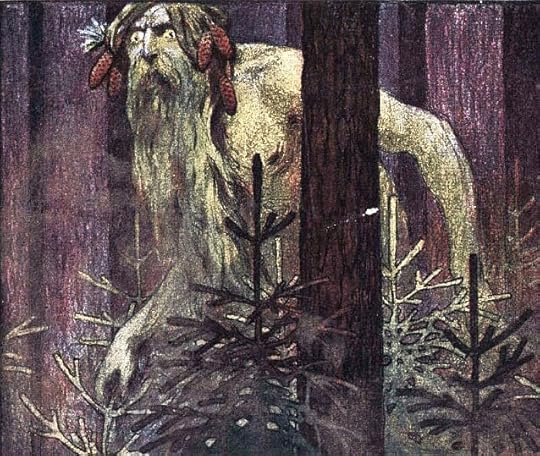
Н. Н. Брут, Magazine «Leshy», Public domain, via Wikimedia Commons.
Even if you don’t see him, you’ll know he’s around. If you come across triangular marks like slingshots, you’ve stumbled upon one of Leshy’s trails. Be warned: he leaves no footprints, so you won’t know if he’s been there recently.
Do you hear the magpies squawking? That’s because they’re his messengers, and they notify Leshy whenever anyone trespasses in his forest. He’s certain to be nearby soon after that.
One thing Leshy is most well-known for is that he loves to play tricks on those who enter the forest. He may appear as another traveler and give you what seem like good suggestions for shortcuts. Don’t be deceived. He’s trying to get you lost. If that doesn’t work, he’ll remove boundary rocks or signposts. Or all he has to do is simply walk around his intended victim in a circle. When you’re knee deep in a swamp, you’ll hear him chuckling away at what a good prank he’s pulled.
You can prank him yourself by dressing as he does. He’ll either think you’re another Leshy, or he’ll get a good laugh at your appearance, especially if you’ve stripped naked in the forest to switch your clothing around. In either case, with you dressed like him, he probably will leave you to be on your way.
Bending down to look between your legs and chanting “I walked, I found, I lost” is another way to protect yourself from his games. Leshy will appear from his hiding place and exclaim, “You figured it out.” Then he’ll be gone. You can also try chanting “Sheep’s mug, sheep’s wool” to protect yourself.
To avoid Leshy’s bad side in the first place, ask permission before entering the forest. It is his home, after all, and he doesn’t like trespassers. Even then, it’s best to offer him gifts when you go to the forest, whether it’s for a nature walk or to hunt or cut wood. He likes hardboiled eggs, pancakes, or bread and salt left on a clean linen cloth. He’s even happy if you leave him a cookie (he likes gingerbread) or candy on a stump. Leaving him your first catch of game is another nice offering.
If you want to ask him for help, such as finding lost livestock that may have wandered into the forest, don’t expect Leshy to do it for free. First, though, you’ll have to get his attention—if the magpies haven’t already alerted him. One method is to cut down several birch saplings. With their tips all touching, position the trees in a circular formation. Stand in the center and yell, “Grandpa!” for that is a term of respect.
If you want to make sure he looks more human when you call him, say this instead: “Grandpa, come to me now, not as a gray wolf, not as a black raven, not as a flaming fir tree, but in the shape I wear.” Otherwise, he could appear as anything: a hare, wolf, bear, raven, pig, horse, rooster, flaming fir tree, or mushroom (Amanita muscaria), in particular. Stories tell about how one creature or another dissolved into the air after they tried to capture it. This, of course, was Leshy in disguise.
Before he makes his bargain with you (and beware, he usually gets the better deal), he may attempt to frighten you by barking, neighing, howling, or any sound of the forest, as well as hysterical laughter. At other times, you’ll know he’s nearby because the trees rustle as he rocks on their boughs, he whistles but forbids others to do so, he claps his hands or cracks a whip. The strong wind that blows around him creates an eternal echo of his sounds.
For the most part, though, he’s only out for a good laugh while he’s out protecting his home.
Kickstarter CampaignThe Lesnik in our story is like the one described above. He’s out to play trick on Theo.
We’re planning to launch the complete Dragon Village series on September 26. Here’s a preview of our campaign story.

Dangers lurk in Dragon Village, but also secrets. Can Theo solve the mysteries before an evil creature conquers the magical and human worlds?
Do you have an adventurous soul, ready to encounter strange magical creatures?Have you ever wished you could travel through a portal to another world?Do you love the reluctant hero, strong female friends, and quirky sidekicks?If this sounds like you, then step through the gate into the magical world of Dragon Village.
Campaign link: https://www.kickstarter.com/projects/ronesa-aveela/dragon-village?ref=3i92sy
If you’re interested in forests and tree, why not check out one of our latest books, Magical Healing Trees in Slavic Folklore, available direct from us or from retail stores.
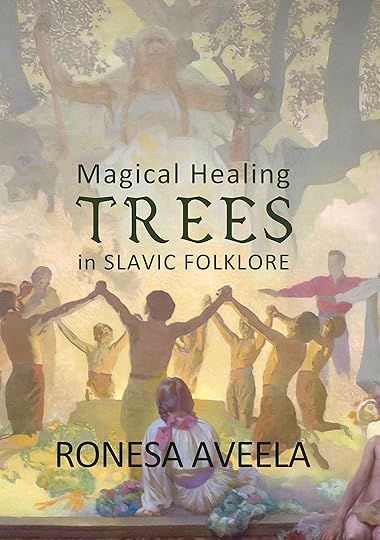
August 18, 2023
Beware the Karakonjul During the Dirty Days
You’re probably familiar with a centaur, a half-man, half-horse creature from Greek mythology. But have you heard of the karakonjul? He appears in Slavic and Turkish folklore.
His lower body is that of a horse with a dog, sheep, or livestock tail, while his upper body is a grotesque, hairy human-like being. One or two horns may sprout from his overly large head. He often has a single eye, and he may even have wings. The creature is a shape-shifter who may take on human form, or an animal such as a dog, cat, sheep, or calf.
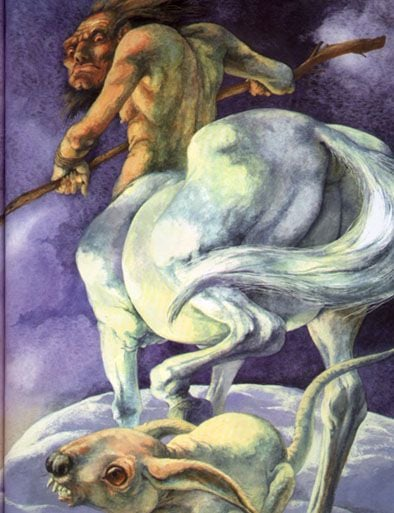 Karakonjul illustration by Bulgarian artist Viktor Paunov from Vampiri, gunduratzi, zmey (Krassimir Mirchev, Panorama Publishing House, Sofia 1998). Source: old.omda.bg.
Karakonjul illustration by Bulgarian artist Viktor Paunov from Vampiri, gunduratzi, zmey (Krassimir Mirchev, Panorama Publishing House, Sofia 1998). Source: old.omda.bg.In some instances, he’s a creature who asks favors of lost travelers, or he may pepper them with riddles. To be safe, you must include in each response the Turkish word kara (for “black”). If you’re polite and kind to him, the creature may provide you assistance. Those cases are rare, however.
More often than not, he’ll harm those he encounters. He’s particularly fond of jumping on the backs of anyone who gets too near and riding them like horses until they die. Other malicious activities include climbing a high wall or cliff and throwing his victim into a deep well or other body of water, or hanging his prey on a tree as a decoration.
Fortunately, your chances of encountering him occur only during the Dirty Days, the twelve days from Christmas Eve until St. Jordan’s Day, the Epiphany (January 6). This is the time of year when the boundary between the spirit and human worlds is thin and those on the other side can easily pass over to our world. During this time, the cosmos is said to return to a state of chaos. And so, it’s no wonder that the karakonjul wreaks havoc in the world during the time he’s allowed to cross over.
He appears after midnight. You’re likely to find him at crossroads, bridges, abandoned mills, and other deserted places. He may also wander around caves, rivers, and any location where ivy grows. As with other demonic creatures, he disappears at a rooster’s first crow.
If you must venture outside during the time the karakonjul is active, make sure to carry with you white garlic that was part of the Christmas Eve meal, or ashes from a log burned that night. These, as well as iron, fire, incense, and wormwood, are things the beast fears and will offer you a modicum of protection. After St. Jordan’s Day, ashes burned during the Dirty Days are called “filthy ashes.” When discarded, these ashes attract the karakonjul and he feeds upon them.
When he’s not in our world, he and his kind are far below the surface of the World Tree, trying to saw it down to bring about not only the tree’s demise but also the destruction of the world. The creatures almost succeed in their task, but Christmas arrives as they’re about to make the last cut. The creatures abandon their activity so they can cause trouble in the world above. By the time they return to the underworld, the tree has healed itself, and the creatures have to start all over again.
In our Dragon Village series, we call the karakonjul Bor Stobor (whose name translates to a person who is strong as a big pine wood). He has aligned himself with our hero’s enemies, who have promised him that he and his kind can roam free in the upper world every day of the year and not just during the 12 Dirty Days.
Kickstarter CampaignWe’ll be launching the complete Dragon Village series in the September/October timeframe. Here’s a preview of our campaign story.
Dangers lurk in Dragon Village, but also secrets. Can Theo solve the mysteries before an evil creature conquers the magical and human worlds?
Do you have an adventurous soul, ready to encounter strange magical creatures?Have you ever wished you could travel through a portal to another world?Do you love the reluctant hero, strong female friends, and quirky sidekicks?If this sounds like you, then step through the gate into the magical world of Dragon Village.
Campaign link: https://www.kickstarter.com/projects/ronesa-aveela/dragon-village
If you enjoy discovering fascinating details about Slavic creatures, you can also find out more about many in our Spirits & Creatures series:
A Study of Household Spirits of Eastern Europe
A Study of Rusalki – Slavic Mermaids of Eastern Europe
August 4, 2023
The Walled-in Bride

KADIN BRIDGE: Klearchos Kapoutsis from Paleo Faliro, Athens, Greece, CC BY 2.0 <https://creativecommons.org/licenses/by/2.0>, via Wikimedia Commons
When I was a child, I was fascinated by stories my grandmother told me about people or animals embedded into walls or foundations. I also found the thought of it barbaric. Every time I passed by a bridge or church, I wondered who had been embedded there. The reason for doing such a thing was to make the building strong.
Although animals such as roosters have served this purpose in new constructions, physically walling in a human is believed to have occurred only in legends. In real life, it was believed that a person’s shadow could be captured to be built into the wall. The spirit, called a talasum, would remain there for eternity to protect the building.
My grandmother never allowed me to approach a place where a house or other structure was being built. She waited until the walls were as high as us. If we came too near any sooner than that, she told me that the builder could capture our shadow and brick us in.
A scary thought. I had no desire to become a talasum.
Are you wondering how a shadow was embedded?
The process wasn’t that difficult. The builder waited until a healthy, young person passed by. This was often a woman, for reason I’ll tell you about below. The builder then measured the person’s shadow using a white piece of twine. Since a shadow is part of a person when the sun shines, the shadow could be used as a substitute for that person.
Using white may be due to a custom of measuring a dead person for a casket. In this instance, two threads of the material were used, a white one and a black one. The black one was buried with the deceased. The white one, however, was placed somewhere secure in the home, often under the eaves. The belief is that the deceased couldn’t take the luck of the house with him when he was buried. So, in the case of building in a shadow, the white one kept the luck in the building that was being built.
After rolling the measuring material into a ball, the builder buried it into the building’s foundation or wall. Within forty days, the measured person became ill and died. His or her spirit then became the building’s talasum.
Even today, you’ll find people in Bulgaria who believe that every major building has one of these talasums protecting it. If you go out between 8 p.m. and 3 a.m., you may run into the spirit. You will know the spirit is there because it’ll make some noise. If it’s a woman, she may be singing or weeping. A man’s spirit is likely to be playing a kaval, a shepherd’s pipe. The talasum may also appear as an animal, often a dog, bear, or wolf.
Don’t venture too close to the building, because the spirit will attack you.
Women were often those whose shadows were built into walls, at least in legends, particularly if she were nursing at the time. The woman’s fertility was symbolic of sustaining life. In addition, the woman was considered the keystone of the family, the one who kept the family strong. And so, builders believed that a woman’s shadow would be a stronger talasum than a man’s.
The most famous of these talasums in Bulgarian lore is for the Kadin Bridge, built in 1470. It spans the Struma River in a small village called Nevestino. The word “Kadin” comes from a Turkish word that means “of a bride,” making it “The Bride Bridge.” It is the sacrificed bride from which the river earns its name.
The story is one of deceit. When the river waters kept washing away the work Manol and his brothers achieved each day, they decided that they would sacrifice the first wife who came to the construction site the next day. Manol’s brothers warned their wives not to come, but Manol honored their agreement. The next morning his wife appeared and they built her into the bridge. She asked that that leave a hole so she could continue to nurse her son. People claim they can still hear the moans of a weeping woman around the bridge.
This legend inspired me. You will meet the spirit of Struma in our Dragon Village series. In our story, however, Struma gets her revenge on those deceived her husband, Manol.
Kickstarter CampaignWe’ll be launching the complete Dragon Village series in the September/October timeframe. Here’s a preview of our campaign story.

Dangers lurk in Dragon Village, but also secrets. Can Theo solve the mysteries before an evil creature conquers the magical and human worlds?
Do you have an adventurous soul, ready to encounter strange magical creatures?Have you ever wished you could travel through a portal to another world?Do you love the reluctant hero, strong female friends, and quirky sidekicks?If this sounds like you, then step through the gate into the magical world of Dragon Village.
Campaign link: https://www.kickstarter.com/projects/ronesa-aveela/dragon-village
You can also find out more about talasums and other spirits in our book A Study of Household Spirits of Eastern Europe.
July 21, 2023
Kikimora, a Domestic Nuisance
If you’ve watched “The Witcher,” you’ll have encountered a variation of a kikimora in the first season. A swamp kikimora. However, that creature more resembles a bolotnik. This creature likes to frighten anyone who goes near the swamp, and she’ll kidnap children. Another type of kikimora lives in the forest and drags people away. These folks are never seen again. Some stories warn listeners to run if they see a kikimora in a pea field, especially if she’s carrying a large pan, because she’ll fry you on it if she catches you.
However, a kikimora who lives in your home is more of a gentle soul, not a monster that devours people. She’s quite the homebody and doesn’t stray. In fact, it’s quite difficult to get rid of her.
To give you an idea what she looks like, here’s a well-known illustration by Ivan Bilibin.
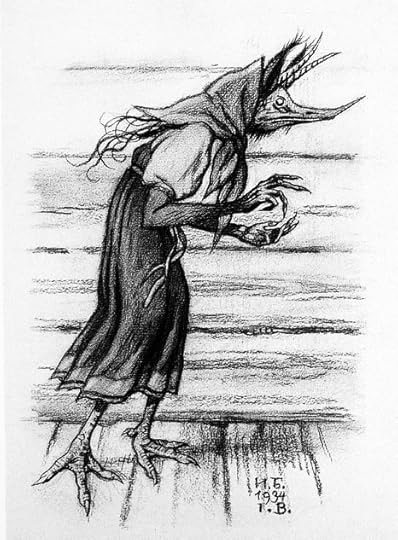
She’s a spirit who lives in your home. She’s restless and moving about all night long. You’ll know she’s there if you hear scratching noises in the walls and floors or pots and pan clattering. In the daytime, she slips away to hide in any crevice she can find. Often, this is behind a hearth or stove, to keep her warm. She’s also been known to hunker down in the cellar, attic, or under floorboards.
She won’t harm you, but you’re likely to be annoyed when you awake in the morning. If you’ve been working with knitting, crocheting, spinning, or sewing projects and have left it you, there’s a good chance she’s tangled it all up, made the stitches uneven, or even torn them out. She wasn’t trying to be mean. She merely wanted to help, but she’s no good at domestic activities.
Even though she always makes a mess of things, if she creeps out a night and finds that YOU have left your home untidy, she’ll have a fit. She’ll show her displeasure in various ways. She may moan, whistle, or whine, sounding like a spinning wheel. Like a pouty child, she may also stamp her feet, slam doors, and scrape chairs across the floor. If your kitchen is messy, she’ll make it even more so. She’ll clang your pots and pans and throw them around, and she’ll break dishes.
But, if you’re home is tidy (before she gets to it), she’ll also protect her family. She’ll warn you if there’s a fire (unless it’s her setting your kitchen towels in fire). She even has a little magic. With the wave of her handkerchief, she can drive the flames away.
She’s a forgiving spirit. If you’ve messed up—literally—and left an untidy house, you can make up for it th the next night by leaving her gifts. Bread and salt often appeal to spirits. She also has a particular fondess for ferns. Besides leaving some for her, you can wash your dishes, pots, and pans with water in which you’ve boiled ferns. That way, she’ll no longer damage the kitchenware.
We hope you enjoyed your visit with this interesting spirit.
Kickstarter CampaignWe’ve been busily finishing up the final book of our Dragon Village fantasy series. We’re now on the home stretch. The final two books are written, and are in the editing process. We plan to launch the completed series of all five books as our next Kickstarter campaign. The timeframe is late September or early October. Be sure to follow the campaign so you’ll be notified the moment it goes live.

Here’s a preview of our campaign story.
Dangers lurk in Dragon Village, but also secrets. Can Theo solve the mysteries before an evil creature conquers the magical and human worlds?
Do you have an adventurous soul, ready to encounter strange magical creatures?Have you ever wished you could travel through a portal to another world?Do you love the reluctant hero, strong female friends, and quirky sidekicks?If this sounds like you, then step through the gate into the magical world of Dragon Village.

Imagine waking up to the rumble of falling water, the scent of spring, enveloping you with radiance and caressing your soul with the thrills of an intoxicating melody. You are next to a small pond where the frogs are lying on green water lilies. Leaves sway from the game of playful fish.
Above you rises the crown of a mighty tree, and on top of it shines like a sun the Firebird. Its colors are like Zuna, the rainbow, arching like a dome over your head. You are still sleepy and haven’t yet woken. From the tree emerges the image of the bird’s patroness, drifting like a morning mist with a soft smile on her marble face. She’s holding a crystal ball.

At the same time, a shadow covers the sky. Above you flies a herd of six-winged deer with glittering amber balls between their horns. Seated on them are women like Amazons, brandishing whips of snakes. The warriors descend with a thud onto the green grass. These beautiful and dangerous Samodivi are dressed in white robes. Their hair floods their bodies like wild foam.
Something disturbs the idyllic moment. The clanging of bells. A group of masked men dance madly. The belt of bells around their waists creates a din that chases away a Karakonjul, a half-man, half-horse creature. The beast shakes his head furiously and turns his one bloodthirsty eye toward you.

A screech adds to the clamor as a house on chicken legs approaches. On its chimney perches a winged purple cat. Not far behind, swimming through the air with a pestle and mortar, the infamous Baba Yaga orders her transportation about with oath after oath.
You try to hide behind the trunk of the tree, encouraged by the smile of the Firebird’s patroness, but something grabs you by the legs. Sharp nails dig into your skin. A bloated, green man with bulging, watery eyes tries to pull you under the water. A Vodnik, a water spirit. You manage to escape. You run, and run, and run. When you think you’ve succeeded, you fall into a dark forest of withered trees, whose bony arms stretch out to grab you.
Amber lights illuminate the trees. Are they fireflies?
No, they’re glass spheres, hundreds of spheres filled with souls.
You close your eyes hoping to wake up from this dream, nightmare. Silence …
Suddenly, hot air breathes onto your face. You open your eyes and scream. A gigantic dragon’s eye pierces your soul.

You close the book’s cover. For this was not a nightmare, but an adventure. You snuggle into your warm bed. Everything around is quiet. The monsters remain hidden between the pages … until you let them loose again the next evening.
This is the world of Dragon Village – Zmeykovo. The books will take you to a world full of familiar and unfamiliar creatures from Bulgarian and Slavic folklore. You will meet a young boy’s friends and experience their joys and sorrows.
Laughter, surprises, fear, nightmares … a recipe for a wonderful adventure.
To become a part of this adventure, join Ronesa Aveela’s Kickstarter campaign. The launch date is set for late September or early October. Sign up to follow it now so you’ll be notified the moment the campaign launches.
If you’re unfamiliar with Kickstarter, it’s a way to get products before the general public. You get not only the books, but also lots of other goodies you won’t find on any retail store. We have fun things planned for this campaign.
If you love DRAGONS, you won’t want to miss this opportunity.Kickstarter link: https://www.kickstarter.com/projects/ronesa-aveela/dragon-villageDownload a FREE sample of the first three chapters of book 1 of the series, The Unborn Hero of Dragon Village.June 23, 2023
Giant Protective Wreath
With the wonderful summer ritual of Eniovden arriving tomorrow, June 24, we’d like to share with you an excerpt from out book written about the herbs used in a magical wreath made especially for this celebration.
***
The herbs collected are powerful, healing, enchanting, and dangerous—and so are the Samodivi, woodland nymphs, who, according to folkloric belief, tend to the plants and all forms of nature. On Eniovden, the 77½ herbs are twisted into a giant wreath for girls to pass through as a right-of-passage into adulthood. According to folk belief, the herbs in the wreath can break spells and drive away a dragon (zmey). It’s well-known that dragons love to capture girls for brides, so the girls need this extra protection as they near adulthood. The girls also place a wreath of herbs on their heads, to deter the zmey from loving them, because the wreath contains herbs that repel dragons and Samodivi as well.
Each of the herbs in the wreath has a special role. Some of the most important are Lady’s bedstraw (see more below), which gives its name to the holiday (Enyovche). It is added for health, while primrose brings wealth, and lemon balm ensures fertility and many children. Other herbs provide protection from evil forces and magic spells, such as primrose again, yellow sweet clover, cowslip, tansy, hellebore, iris, burning bush, and ivy.
Girls and women of all ages gather the herbs early in the morning before sunrise when their healing power is at their peak. If the gathering coincides with a full moon, that’s even better, because the herbs will be more potent. First, the participants must ask the Samodivi for permission to collect herbs on this magical day. The asking, however, is not done with words. The girls pick plants that grow around a holy spring, iazmo, because this is where the Samodivi like to spend their time. Holding each other’s hands, the females twirl around the herbs three times, in a silent horo, a circle dance. Then they immerse the herbs they’ve gathered into the Samodivi’s magical water, silent water, to fill the plants with the power of the nymphs.
If the girls fail to do everything properly, the herbs will become poisonous, not healing, and will be good for only black magic. Many folk songs tell tales of Samodivi who punished people with diseases for their misdeeds.
It’s also traditional to tie a red thread around Eniovden herbs and flowers to make a kitka (bouquet). The red color provides extra protection. People preserve these kitkas in their homes to ensure those living there are protected from diseases and troubles throughout the year. And healers use them to cure sicknesses. At the end of the year, families discard the kitka, its power having been depleted, and make a new one.
As a general rule, herbs are good for one year. This is the reason healers gather only amounts they need, to preserve the herbs for future use. Each healer has her own magical garden, which she keeps secret, to share only with the enchanting Samodivi.
You can learn more about Eniovden and other Bulgarian rituals in my book Light Love Rituals: Bulgarian Myths, Legends, and Folklore.

Description: The stem grows to a height of around 2 to 4 feet (60 to 120 cm). Groups of six to twelve thread-like leaves form a whorl around it. They are shiny and dark-green and have a hairy underside. Bright-yellow flowers gather in dense clusters at the top of the stem. They produce a smooth nut that splits in half when ripe. The plant’s roots are shallow.
History and Traditions: The genus name comes from the Greek word gala for “milk,” owing to the fact the plant was traditionally a way to curdle milk for cheese making and produce the yellow color of cheese. Verum is Latin for “true.” The plant gets its common name from medieval times, when the dried plants, which were soft and springy, were stuffed into mattresses, often for pregnant women. The herb’s scent not only acted like a flea repellent, it was also believed to help with a safe delivery. Other origins of the name say it refers to herbs found in the hay in Jesus’s cradle in the Bethlehem manger. In Scandinavia, the herb was called “Frigg’s grass” after the goddess of married women, and it was administered as a sedative to women giving birth.
Habitat and Distribution: Native to Europe and northern Africa, and it has been naturalized in North America and New Zealand. The plant grows abundantly in meadows and fields and along roadsides, and it is found in maritime locations.
Growth: Perennial. The plant blooms from July to August, and the seeds ripen from August to September. It prefers dry or moist soil and grows in well-drained sandy, loamy, and clay soils, anything but the most acidic soils. It can flourish in full sun, although it prefers partial shade.
Harvesting: Flowers and leaves are used. Harvest the plant when it blooms. Spread the stems out in thin layers in a shady, well-ventilated area to dry.
Medical Use: In folk medicine, people wash their faces with a decoction to firm their skin or to relieve eye pain. It’s also drunk to stop nosebleeds. Combined with olive oil, the decoction is applied to the skin to relieve boils. Rinsing one’s head with an infusion of the herb is a treatment for dandruff, and creams with the herb are a treatment for psoriasis. Other uses are for fever, hoarse voice, stomachaches, painful menstruation, and depression. More serious afflictions it has been a remedy for include kidney and liver disease and epilepsy.
Rituals and Magical Use: This is one of the most important herbs woven into the giant Eniovden wreath. In Bulgarian folklore, the herb provides protection from Samodivi, dragons, and diseases (which were personified). The girls keep bouquets with the herb throughout the year, as it offers them protection and healing. Another Eniovden custom is to decorate a young girl with the herb and parade her around the village as Enio’s bride to commemorate an ill-fated love story about a girl named Stana and a boy named Enio. Fortune telling is another Eniovden ritual. The girls tie rings to the flowering herb and place them in water. The eldest woman from the village removes them one by one and predicts each girl’s future: to one wealth, to another a wedding, and so on. The yellow bedstraw herb also offers protection to pregnant women from Navi, demonic creatures that have a bird-like body and distorted baby’s head. These creatures are known for attacking pregnant women. When a woman is around seven or eight months pregnant, she passes through a large yellow bedstraw wreath three times for protection. The herb is also worn in belts to prevent back pain during the harvesting season. In another custom, yellow bedstraw is added to a child’s bath so he won’t suffer from polio.
Other Use: The leaves can be eaten raw or cooked. The seeds are also edible and can be roasted as a coffee substitute. The stem and leaves or flowering top produce a yellow dye and food coloring, and the roots a red one, although the roots are too insignificant to make this a profitable venture. Adding a bit of the herb to your shoe is done to prevent blisters.
Other Names: Lady’s bedstraw, Our Lady’s bedstraw, yellow bedstraw, yellow spring bedstraw, maid’s hair, cheese rennet.
Aromatic: The flowers are odorless, but the dried plant smells like newly mowed hay. The herb has a bitter taste.
CAUTION:Large doses can cause headaches, allergic reactions, and rashes.
Treating WoundsGrind the herb into a powder, which can be sprinkled onto inflamed wounds. This is purported to protect against secondary infection.
Our Lady’s BeddingA medieval legend says that the Virgin Mary gave birth on lady’s bedstraw and bracken. The lady’s bedstraw bloomed in recognition of the holy child, and the faithful plant’s flowers changed from white to gold. The bracken, however, refused to acknowledge Jesus, and as a result, it lost its flower.
If you enjoyed this sample, you can discover more about the herbs that are used in this magical wreath in our book 77 1/2 Magical Healing Herbs.
May 26, 2023
Dancing on Fire
The hot, humid days of summer will soon be upon those of us who live in the northern hemisphere. I look forward to warmer weather. Here in New England, the temps are up and down. We have a saying not to plant our gardens until after Memorial Day, for fear of frost.
Today, we’d like to tell you about another hot topic—fire dancing, or nestinarstvo. May 21 marks the celebration of Kostadinovden, the Day of Saints Constantine and Helena. You may be familiar with Constantine and his legalization of Christianize across the Roman Empire and making it the dominant religion. But, did you know he had an association with the fire dancing as well?
A popular legend says that God once looked for an assistant from among unmarried men to help Him manage people. God wanted to find a good way to test a person’s loyalty. Then an idea came to Him: a fire dance. He built a fire that burned toward the heavens. It burned for a long time. When only glowing embers remained, God said the whoever could walk on the coals with his bare feet would be His assistant. Only Constantine was brave enough to try. He danced on the coals unharmed, proving to God his heart was pure, and so he became God’s assistant. Constantine’s task thereafter was to make sinners dance upon the embers. This was done in an effort to burn away their sins, since people believed fire had magical powers to purify whatever passed through it—both objects and souls.
Even though fire dancing is an ancient ritual of pagan origins, St. Constantine, who was said to worship fire, permitted it to continue. However, the ritual was almost wiped out during the 1912 Balkan War. Today, it continues in remote parts of the Strandja Mountains, such as the village of Balgari, because these places were difficult to reach during the war.

The Thracian word nestia means “fire.” Some say nestinari originates from the Bulgarian word nistina or istina (truth), since the dancers were true Christian believers. Others say that Nestinarstvo comes from the Greek words for fasting (nisteía) and fire (estia), because prior to conducting the ritual, the dancers fast and abstain from alcohol and evil thoughts to prepare themselves with the sacred dance. Some texts say Thracians originally performed the ritual in honor of the Great Mother Goddess Bendis and her offspring, Sabazios, the Sun god.
In the time of the Thracians, priestesses performed the ceremony. They were considered to be sun brides and wore their headscarves in the same manner a bride did. Today both men and women participate, and either a man or a woman can be the lead dancer.
The ability to dance on coals is considered a divine gift, one often passed down within a family. This lead dancer chooses her replacement when she can no longer perform the ritual. Often the successor is a son or daughter, since people believe the parent passes on to his child not only the skill to walk on coals, but more importantly, the ability to predict the future.
The Nestinarstvo celebration is performed to ensure health and fertility, not only for people, but also for animals and land. It holds traces of Dionysian mysteries that mark the rebirth of nature and the world.
Those present at the dance form three or nine circles around the area where the dancers perform the ritual. These circles are associated with the Sun, the “Fire of Heaven.” Both fire and water are connected with the ritual. Fire has protective properties and increases the Sun’s divine power, while water has the capacity to heal. The dancers claim that while they are in a trance, the coals look as if they’re covered with water.
Magical aspects of the ceremony have also survived. In ancient times, the nestinari were leaders of the village. While they were in a trance, they contacted their ancestors, then made predictions and performed healings. Nowadays, nestinari claim reverence to the saints gives them protective power so they can dance on embers without injuring themselves.
Once they have entered a trance or prihvashtane (possession), the dancers feel pulled toward the fire with all their senses. The outside world disappears as they communicate with the saints. As they dance, they neither see nor hear what is happening around them while they leave their physical world and enter the invisible realm. The path they walk along on the embers is viewed as a temporary death, that allows them a new birth from which they receive knowledge from the beyond. They believe Saint Constantine embodies himself not only within the nestinari, but also within the instruments and music that play while the nestinari dance, much like a pagan belief that the gods could reincarnate themselves in sound and instruments.
To find out more about this and other Bulgarian customs, check out our book Light Love Rituals.
May 12, 2023
Dancing Away Evil
I spotted an article in The New Yorker magazine last week about a fascinating documentary by Killian Lassablière. Why am I sharing this you may ask? Because he portrayed the tradition of the Kukeri. This is one of the Bulgarian rituals that have fascinated me since childhood. I have memories of seeing the masks, the sound of the chimes and bells, and the flaming torches. It’s difficult to depict with words. You need to be there to see and feel the power.
This is why I include the ritual in my book Mystical Emona and also have Kukeri as characters in the Dragon Village series. These Kukeri, Jega, Mraz, and Zima, are depicted as powerful protectors, who use their magical abilities to ward off evil forces and ensure the safety of their village. They are closely connected to nature and the cycles of the seasons.

The Kukeri ritual is usually performed in the winter months, particularly around the winter solstice and New Year’s. The performers wear elaborate costumes that are often made of sheepskin or other animal furs and decorated with colorful ribbons, bells, and masks. The masks can be made of wood or leather and are carved to resemble animals, demons, or other mythical creatures. Some masks are also adorned with real animal horns or antlers.
The dance is traditionally performed by men, but in these more modern times, females also participate. The ceremony begins when the participants gather in a central location, such as a village square or a churchyard. The Kukeri dance through the streets, making loud noises with the bells that surround their waist and with other instruments. As they dance, they chant and sing songs to drive away evil spirits and bring good luck and prosperity to their community.

The Kukeri ritual is deeply rooted in Bulgarian folklore and mythology. The costumes and masks the performers wear have symbolic meanings that are connected to ancient pagan beliefs. For example, the animal furs represent the power of nature, while the masks represent the spirits of the ancestors and other supernatural beings.
This ancient tradition has inspired many artists and filmmakers over the years. The short film I mentioned above that was published by The New Yorker magazine, for example, features stunning footage of the Kukeri performers in action. The film also highlights the importance of preserving this ancient tradition for future generations.

As you may know, my books are inspired by Slavic and Bulgarian mythology and folklore. My latest project is no different. It is inspired by magical healing trees that possess the power to cure even the direst of illnesses. Mystical creatures like nymphs protect the trees and dance around them, casting spells and performing healing rituals. Others believe that gods, spirits, or saints protect the trees. If you’re ready to experience the magic of the forest like never before, please visit our project.




